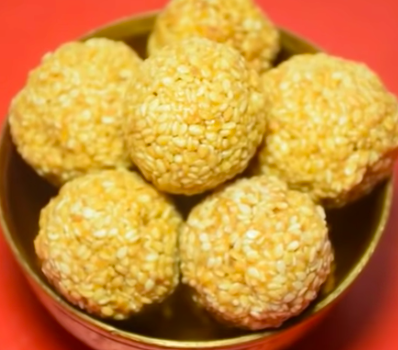In Bengal, the utensils are important, and the source of the raw ingredients is crucial, and the process is twice as important. This recipe is by Dr Pragya Ray and Dr. Sumit Sur, medical officers at Sanjeevani Bhesaj in Purba Midnapore, West Bengal.
| Ingredients | Instructions |
| iron vessel earthen pot 250 gm til (sesame seeds without husk) |
Step 1. dry roast the sesame seeds on low flame, stirring continuously to prevent overheating or burning. Use an iron vessel. When a nice aroma is emitted after 3-4 minutes of stirring, with a slight darkening of the seeds to a golden brown, remove from the kadai and place into an earthen pot. |
| 300 gm gur (jagarry) | Step 2. add the gur to the iron vessel and heat with water to allow it to melt on medium heat, continuously stirring about 5-6 minutes, until the jaggery's frothing will disappear. |
| 5 gm fresh adraka paste (ginger) | Step 3. Mix in adrak paste and stir well for 5-8 minutes on low heat, then remove the vessel from heat. |
| wooden spoon | Step 4. Take about 10gm of the hot mix in a spoon and add some of the roasted sesame seeds kept in the earthen pot, coating the mix fully into a mini ball size, known as a Nadu, while it is still warm. Serve after it cools. |
The terms nadu, naru, and ladoo indicate linguistic variations commonly found in adjacent cultures and regions of India. The terms refer to the ball-shaped snack food that is either sweet or savory and usually contains some bean, nut, or vegetable and often some sweet flavor.
The health benefits of the sesame ball are clearly mentioned in Ayurveda in the following references. In this formulation, three ingredients are used, all of which have highly medicinal value. The guna (quality) of each ingredient has effects on the VPK doshas.
Tila / Sesame
The Sesame plant is known as tila/til/तिल throughout South Asia and its products are vata-shamaka. The adjective -shamaka means that til lowers the vata that is unbalanced and flowing around in the body as micromovements that disrupt the harmony of the body's systems. To lower vata means to restore balance in subtle, micro and macro movements in the body. Subtle movements affect the mind and the intuition. Micromovements affect the cellular processes such as DNA, nerve impulses, cleaning going on in the liver every moment, and the exchange of air in our lungs with the toxins in our blood. Macromovement affect things we can sense with our 5 senses, such as movement in our muscles, joints, our circulation of blood, wind or food moving through our gut, and our breath.
The wise doctor Bhava Mishra, who lived in the 16th century CE (in the Common Era), reinterpreted the classic medical texts to bridge philosophy and medical practice, as well as practical recipes. He describes tila -
तिलो रसे कटुस्तिक्तो मधुरस्तुवरो गुरुः | विपाके कटुकः स्वादुः स्निग्धोष्णः कफपित्तनुत् ||
बल्यः केश्यो हिमस्पर्शस्त्वच्यः स्तन्यो व्रणे हितः | दन्त्योऽल्पमूत्रकृद् ग्राही वातघ्नोऽग्निमतिप्रदः ||
Source: Bhava Prakash Nighantu, Dhanyavarga, 53-54
Translation: The properties of til (sesame) are its rasa (taste), which it pungent (katu) and bitter (tikta). Due to its madhura quality (fulfilling, pleasant), it is also somewhat heavy to digest, but helps build the body tissues (by cleaning out undigested things stuck in the channels leading to those tissues). | The vipaka (post-digestive use in the body) is katu (a pungence of heat-producing effects); swadu (fulfilling), snigdha and usna (lubricating and heating); and balances any kapha or pitta that is not working harmoniously in the body. || Til improves physical strength, hair, and relieves coldness on the skin, breast milk production, and helps heal wounds. | Til improves the teeth, low urine flow, gut absorption of nutrients in cases of irritable bowel, and destroys vata and improves the digestive fire (agni) by cutting through undigestible elements. ||
In practical terms, this means that sesame is beneficial to the body due to its heat and cleansing effects. It both helps build and maintain body tissues, especially muscles and joints on which it is rubbed, and it helps warm the body and clean out inflammation. This is why people do gandoosha (oil-pulling) with sesame oil, and eat moisturizing sesame seeds in larger amounts during the cold, dry season of early winter. It is also excellent on the external body as a massage oil when it is cold and dry. However, just as til oil spreads warmth, it also spreads whatever is in the channels, so it there are toxins or autoimmune antibodies, those also get distributed into deeper tissues. This is one caution for unhealthy people, to avoid plain sesame oil massages. For healthy people, sesame-laden foods are only to be eaten during the cold, dry season.

-Photo credit: Dr. Pragya Ray
Jaggery / Unrefined Cane Sugar
Gud/jaggery is unrefined sugar and is a pitta-shamaka substance. It pacifies the qualities of pitta, especially the fiery inflammation that results from too many chemical substances that create too much heat without creating heat that can actually be useful to the body, such as that heat which assists digestion, warms the body, or produces heat needed to enzymes or hormones to be properly formed and released into action. Refined white sugar is produced through intense heat-requiring processes and goes into the body and inflames it, as we see with diseases such as diabetes that are increased by white sugar.
A wise doctor of the 11th century CE, Chakrapani Datta wrote several medical books, including the Dravya Guna Saṃgraha. Dravyaguna is the description of properties (guna) of all substances (dravya). Jaggery is described for its amazing and specific properties.
गुडो वृष्यो गुरुः स्निग्धः सक्षारो मूत्रशोधनः |
नातिपित्तहरो मेदःकफक्रिमिबलप्रदः
Source: Dravyaguna Saṃgraha Nighantu, 9/6
Translation:
Explaining the benefits of gura(jaggery) for the body as a product of iksu (sugarcane), guḍ/gur improves the quality and strength of reproductive functions, especially sex drive. It is guru -- somewhat heavy to digest, but helps build the body tissues due to its high concentration of trace minerals. Fuḍ also is snigdha (lubricating) and due to its alkaline properties, it is mutra-shodhana, helping to clean the urine. | It also defeats the inflammation quality of pitta, and reduces kapha and excess fat, and infections of worms. It gives strength to the body.
In practical terms, jaggery is an ideal alternative to the hyper-purified and bleached white sugar. The closer we can use sugars from their original sources, the more easily our body can utilize them without provoking the liver and its call to the pancreas for sugar metabolism.
Adraka / Fresh Ginger
Adraka is raw fresh ginger root that has not been cooked or dried and has its own juice inside. This juice ignites the digestive fire in the belly, known as deepana, and this fire helps digest out toxins and undigested complexes, food materials, and bizarre chemical combinations that have formed in the belly due to incompatible foods causing chemical reactions that are not useful for human digestion, known as the action of pachana. Adhraka also creates lightness in the body, and it is easy to digest. Ayurveda advises that it can be used for a host of actions, especially medical conditions like chronic indigestion, and mucus in the lungs, since there are blood vessels between the upper stomach and the trachea of the lungs.
As one of the greatest books diving into deeper details of therapeutic properties of drugs, the Dhanvantari Nighantu was written in the 13th century CE; its author chose to remain unknown as s/he felt the knowledge belonged to all.
कटूष्णामार्द्रकं हृद्यं विपाके शीतलं लघु | दीपनं रुचिदं शोफकफकण्ठामयापहम् ||
कफानिलहरं स्वर्यं विबन्धानाहशूलजित् | कटूष्णं रोचनं वृष्यं हृद्यं चैवाऽऽर्द्रकं स्मृतम् ||
Source: Dhanwantari Nighantu, 2/11-12
Translation:
Fresh ginger (adraka) is katu (pungent in nature) and usna (produces warmth in the body) as vipaka (post-digestive use in the body). It is hridya, producing both benefit for the heart, a sense of happy appetite and balance. Its aid to digestion helps complete work of the digestive fire and then rescues the belly, rendering it sheeta (cooling) and laghu, creating both lightness in the body, and creating an environment of easy digestion. | Adraka is deepana (lights the digestive fires), ruchidam (increasing appetite and making things taste better). It is used for diseases of swelling, phlegm in the throat (kantha) and similar diseases of kapha origin.|| It reduces kapha and excess wind in the gut, the voice, vibandha (stalling in the intestine, that shows up as constipation), and removes pain. | Its pungent and heat-producing properties (katu-ushnam) help detach phlegm from the side of the gut and send it downwards, known as rochana. Like jaggery, it is vrishya, improving the quality and strength of sex drive and reproductive functions. ||
In practical terms, Indian ginger is a medicine and a spice. It is used fresh and known as adraka. It is used dried and shown as shunthi powder and it is used as decoction. It is commonly added to cooking to enhance pungent flavor, and it is added to meats and heavy vegetables to enhance digestibility. It is also a key component in many ayurvedic medicinal formulations.
Summary
This articles provides a recipe for sesame snacks and gives detailed information on the medicinal properties of each ingredient, the source texts for that medicinal information, and some historical information about each text. It also teaches several basic concepts of gut physiology and suggests the mechanisms for ayurvedic thinking about digestion.

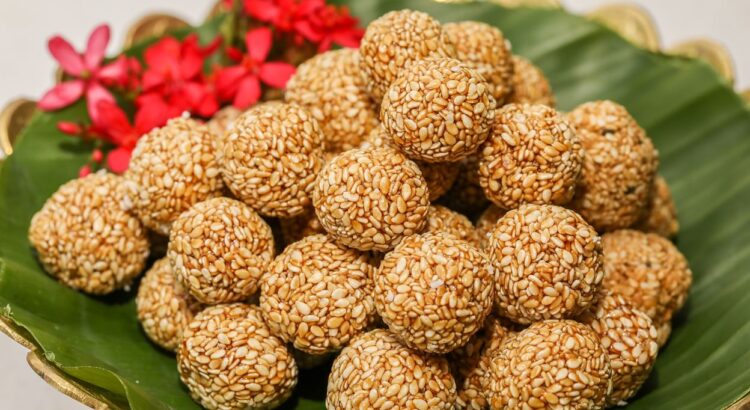
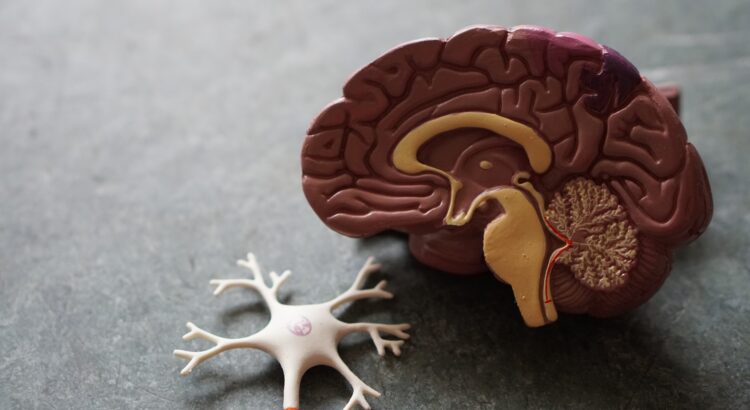



 Then we had to be sure the time was right. Good Dot as a brand is growing and we have fairly strong national presence in every state of the country. We got into modern trading and e-commerce, which is more directly main stream. We needed a brand ambassador to give us the inorganic push and fairly good visibility.”
Then we had to be sure the time was right. Good Dot as a brand is growing and we have fairly strong national presence in every state of the country. We got into modern trading and e-commerce, which is more directly main stream. We needed a brand ambassador to give us the inorganic push and fairly good visibility.”




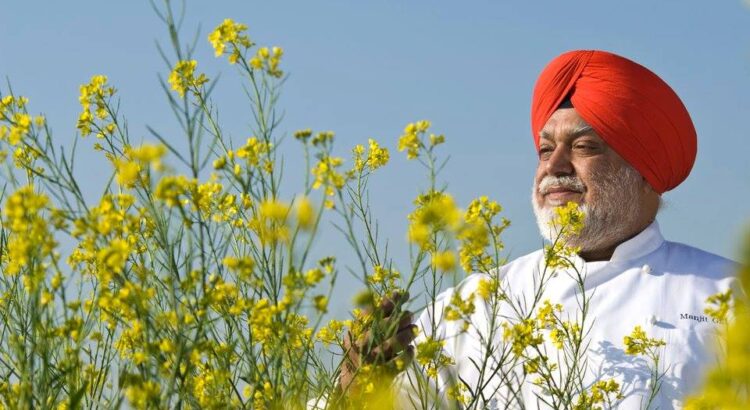




 The brand aligns with the company’s philosophy of offering high-quality, healthy, authentic food products to consumers that nourish their taste buds and their bodies. The vegan and vegetarian friendly range launched in the initial phase includes six products - Kebabz, Keemah, Nuggetz, Pattiez, Popz, and Sausez.
The brand aligns with the company’s philosophy of offering high-quality, healthy, authentic food products to consumers that nourish their taste buds and their bodies. The vegan and vegetarian friendly range launched in the initial phase includes six products - Kebabz, Keemah, Nuggetz, Pattiez, Popz, and Sausez.
 Aayush, the sustainable health-focused vegetarian menu brings back traditional Indian recipes that are rich in nutrients, low in calories and with natural healing properties. It will be available in all properties across India, curated by the culinary team in Hilton.
Aayush, the sustainable health-focused vegetarian menu brings back traditional Indian recipes that are rich in nutrients, low in calories and with natural healing properties. It will be available in all properties across India, curated by the culinary team in Hilton. Commenting on the new menu, Prashant Kulkarni, Director F&B, India-Hilton said, "We at Hilton are amongst the pioneers in India to bring wholesome and mindful food options alongside our regular menu. It is part of our continuous endeavour to support the growing appetite for sustainable dining. In the past, our association with Wakao foods was welcomed by our guests for its innovation, sustainability, and deliciousness. Now with Aayush, we want to expand and cater to our conscious consumers with a satisfying meal, making dining out at any Hilton brand across the country a friendly and reliable experience. The menu includes immunity-boosting dishes like "Moringa Saaru," a drumstick soup from Southern India that is full of potassium, vitamin C, and other essential nutrients.”
Commenting on the new menu, Prashant Kulkarni, Director F&B, India-Hilton said, "We at Hilton are amongst the pioneers in India to bring wholesome and mindful food options alongside our regular menu. It is part of our continuous endeavour to support the growing appetite for sustainable dining. In the past, our association with Wakao foods was welcomed by our guests for its innovation, sustainability, and deliciousness. Now with Aayush, we want to expand and cater to our conscious consumers with a satisfying meal, making dining out at any Hilton brand across the country a friendly and reliable experience. The menu includes immunity-boosting dishes like "Moringa Saaru," a drumstick soup from Southern India that is full of potassium, vitamin C, and other essential nutrients.”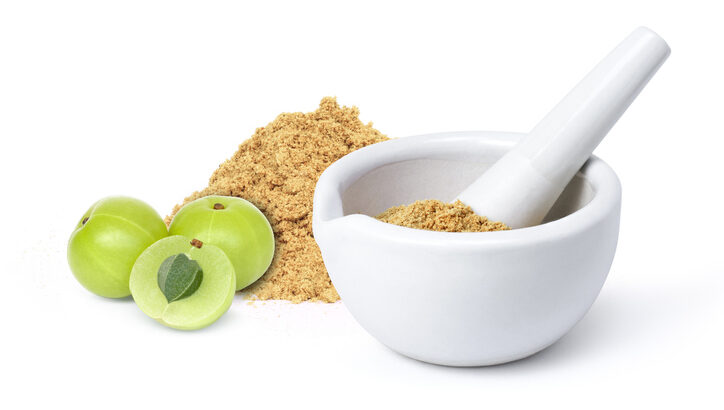
 Amalaki, known as amla, avra and nelli, also has a multitude of both regional language names and variety names. Amalaki rose to fame outside India due to a solitary study that verified high vitamin C content, showing it contained 479 mg of Vitamin C in 100mL of juice or 750-850 mg of Vitamin C in 100 gram of fruit pulp, compared to other common fruits apple, lime, pomegranate, and two types of grape (ref PFHN, 2004, Jain, Khurdiya).
Amalaki, known as amla, avra and nelli, also has a multitude of both regional language names and variety names. Amalaki rose to fame outside India due to a solitary study that verified high vitamin C content, showing it contained 479 mg of Vitamin C in 100mL of juice or 750-850 mg of Vitamin C in 100 gram of fruit pulp, compared to other common fruits apple, lime, pomegranate, and two types of grape (ref PFHN, 2004, Jain, Khurdiya).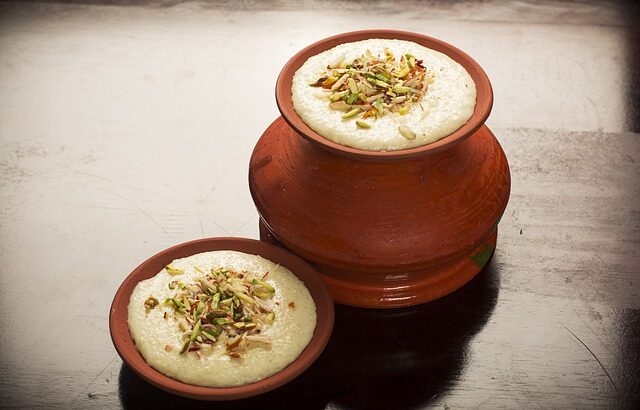

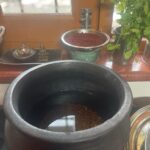

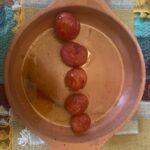
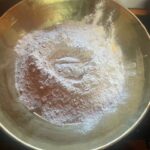

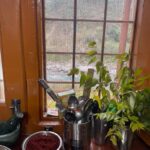
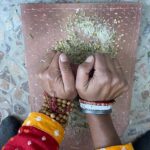
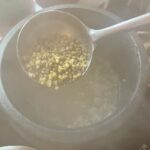

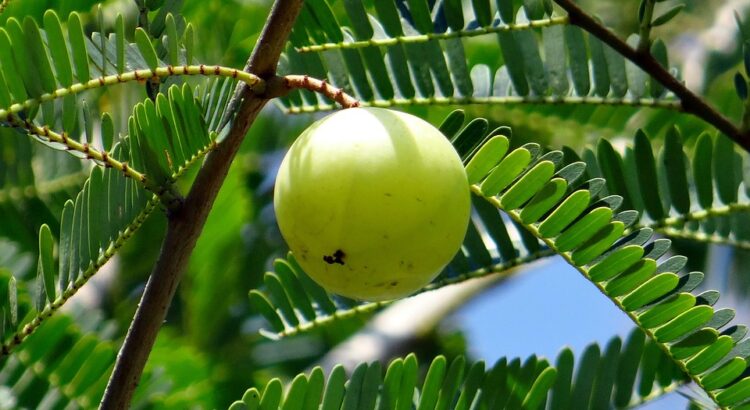
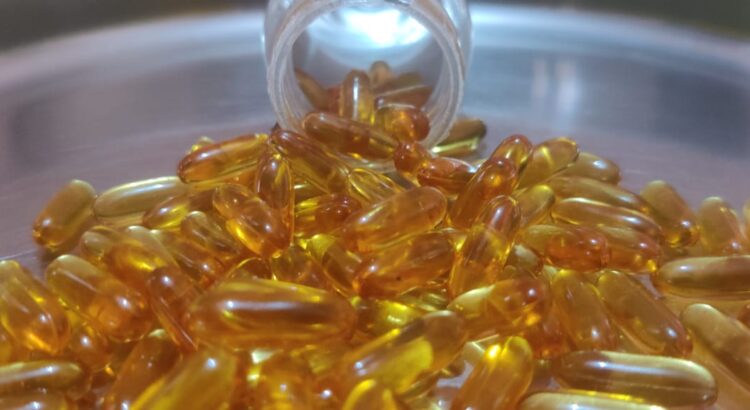
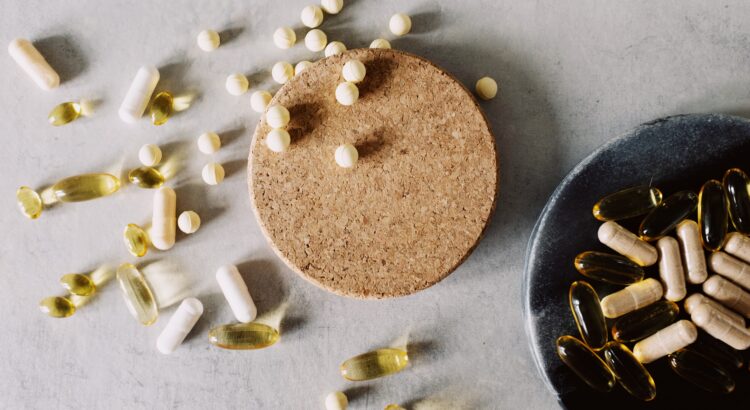
 Around the world, the burgeoning industry of dietary supplements has required laws that protect it from pharmaceutical regulations for chemical compounds and allow patients the freedom to use products such as vitamins, probiotics, extracts, herbs, protein powders, and minerals as well as trace elements without fear of domination over their personal health choices. This tension is best seen when food is considered medicine.
Around the world, the burgeoning industry of dietary supplements has required laws that protect it from pharmaceutical regulations for chemical compounds and allow patients the freedom to use products such as vitamins, probiotics, extracts, herbs, protein powders, and minerals as well as trace elements without fear of domination over their personal health choices. This tension is best seen when food is considered medicine.
 Speaking about the decision in a press announcement, Anushka Sharma said, "Virat and I have always been animal lovers. It's been years since we decided to adopt a meat-free lifestyle. The collaboration with Blue Tribe is a step to tell people how they can be more conscious and leave less impact on the planet by switching to a plant-based diet.”
Speaking about the decision in a press announcement, Anushka Sharma said, "Virat and I have always been animal lovers. It's been years since we decided to adopt a meat-free lifestyle. The collaboration with Blue Tribe is a step to tell people how they can be more conscious and leave less impact on the planet by switching to a plant-based diet.” Sohil Wazir, (Chief Commercial Officer, Blue Tribe Foods) in an interview with Ayuve, shared, “You are aware that Blue Tribe is into plant-based meat. Through our marketing initiatives we are trying to reach out to more and more people and show how meat consumption is damaging the planet. We want to tell them there are meat-free alternatives that are similar in taste and texture. As part of our marketing, we have been taking on chefs who cook predominantly non-vegetarian food, and asking them to create recipes with our products. This continues to be our content building exercise. We are also available in Five-Star hotels’ menu and the recipes made using our products are named after Blue Tribe. We worked with Anahita Dhody for NDTV Food channel. Currently we are working with Chef Varun Inamdar for his very popular show ‘Get Curried’. People who are into vegan food already know us; it is the early adapters we want to reach out to.”
Sohil Wazir, (Chief Commercial Officer, Blue Tribe Foods) in an interview with Ayuve, shared, “You are aware that Blue Tribe is into plant-based meat. Through our marketing initiatives we are trying to reach out to more and more people and show how meat consumption is damaging the planet. We want to tell them there are meat-free alternatives that are similar in taste and texture. As part of our marketing, we have been taking on chefs who cook predominantly non-vegetarian food, and asking them to create recipes with our products. This continues to be our content building exercise. We are also available in Five-Star hotels’ menu and the recipes made using our products are named after Blue Tribe. We worked with Anahita Dhody for NDTV Food channel. Currently we are working with Chef Varun Inamdar for his very popular show ‘Get Curried’. People who are into vegan food already know us; it is the early adapters we want to reach out to.”




